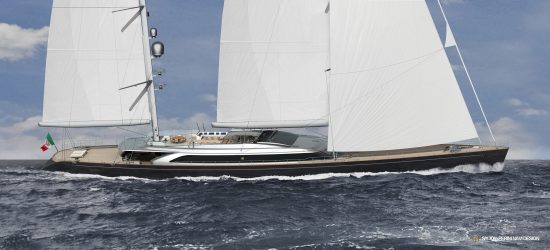
The largest and most advanced sailing project to come out of the Perini Navi shipyards since The Maltese Falcon the 70 metre Sybaris has been launched in Italy
The ketch rigged yacht boasts a total sail plan of 5,842 sqm and has been constructed for an owner whose other yacht is the 52 metre motor yacht Rassalas
Built to uncompromising levels of quality, comfort and safety that characterise all Perini Navi yachts, Sybaris has taken design and engineering have been taken to the next level.
The French naval architect Philippe Briand, was called in by Perini to optimise the naval architecture and powerful sail plan. His advice included moving the mizzen mast further aft, for example, to provide more ‘clean’ air between the main and mizzen sails and improve sailing performance.
This required close collaboration with the in-house design team, not least because the mizzen mast usually rests atop the engine room bulkhead, but also enhanced the layout of the cockpit by introducing space for a full-size circular dining table be-tween the mizzen mast and the 4m-wide glass entrance to the main salon.
Another conspicuous evolution, this time introduced by the owner’s team, is the dynamic wave-like design of the steps on both sides of the cockpit for a flowing connection with the open aft deck.
The overhang of the superstructure brow above the windows has also been completely eliminated to present a flush surface that serves to lighten the visual impact of the superstructure profile. For the same reason, the section of superstructure forward of the helm station on the fly bridge is painted the same dark grey as the hull, and the engine room ventilation grilles have been restyled to seamlessly merge with the side windows.
Beyond her cutting-edge aesthetics, performance under sail is a key element of the Sybaris ethos. To this end, the carbon fibre spars and Carbo-Link standing rigging supplied by Rondal are equipped with an advanced monitoring system that provides constant feedback on rig loads via a series of sensors.
The electric in-boom furling systems of the composite booms are the first of their kind produced by Rondal. The fully mechanical reefing points on the masts supplied by Equiplite represent an innovation in halyard-lock performance: gone are the days of “missing” the lock as the main halyard car engages automatically every time.
Electric variable-speed captive winches and furlers, duly synchronised and monitored by the automated sail handling system, speed up tacking and jibing by dramatically improving the furling and deploy times of the North Sails 3Di wardrobe of sails. The reacher/blade winches, for example, pull a maximum load of 35 tonnes and have a maximum line speed of 75 m/min.

Nice yacht!